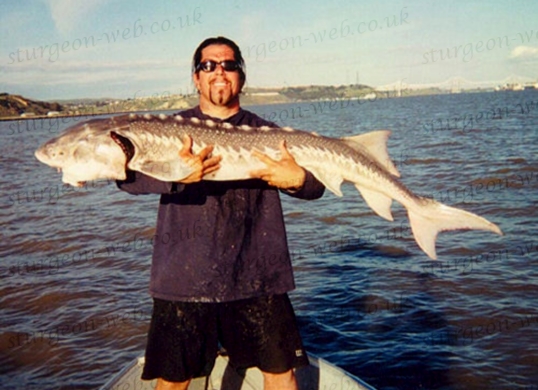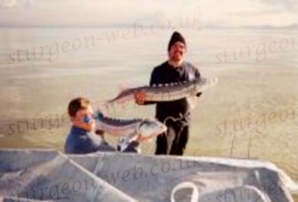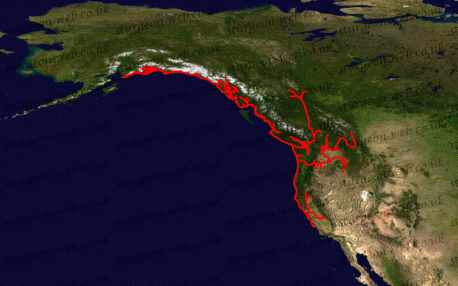White sturgeon (Acipenser transmontanus)
Adult White Sturgeon (Acipenser transmontanus) feeding at Vancouver Island University
The White Sturgeon (Acipenser transmontanus) is found on the west (Pacific) coast of North America from Alaska, Canada down to California. While the White Sturgeon produces good caviar it is a bit oily.![]()
Description
Acipenser transmontanus has 11-14 dorsal scutes, 38-48 lateral scutes, 9-12 ventral scutes, 44-48 dorsal fin rays and 28-30 anal fin rays. The colour is grey to blue-black on the back, changing through light grey on the sides to white on the belly. The species can grow up to 6.1m in length and 815kg in weight and can live for 100 years or more.![]()
Although only currently accepted as one species (Acipenser transmontanus), a recent study based on morphological, osteological and biological evidences, suggests that the White Sturgeons of the Pacific coast of North America are composed of two distinct species, belonging to two genera.![]()
The study states that:
- The White Sturgeon populations in the Frazer River, the Columbia River and the Sacramento River with the characteristic short snout belong to the Genus Huso and therefore require a taxonomic revision of the scientific name to Huso transmontanus and the common name Steluga Sturgeon.
![[This work is copyright © 2000-2024 www.sturgeon-web.co.uk]](img/copyright.gif)
- The populations in the Nechako River, the Kootenai River and the Snake River with the characteristic long snout belong to the Genus Acipenser and for these a new species is proposed with the scientific name Acipenser columbiaensis and the common name Columbia Sturgeon.
![[This work is copyright © 2000-2024 www.sturgeon-web.co.uk]](img/copyright.gif)
Recommended Pond Size
The White Sturgeon is one of the largest growing sturgeon species. It has been known to grow to 6.1m (20ft) long and weigh up to 816kg in the wild and grows quickly in ponds to a very large size. To keep this species in a pond you will need a pond of at least 15,000 gallons (68,000 litres) and plenty of money to meet the huge food bill. As with the Beluga sturgeon (Huso huso), a White Sturgeon will need a lot of feeding if you want it to leave your other fish alone.![]()
Food & Feeding
2 year old White Sturgeons (Acipenser transmontanus) feeding at Vancouver Island University
Sturgeons DO NOT, as some people would have you believe, eat banket weed or 'clean the bottom of the pond'. Sturgeons need to be fed all year round, they need 2-3% of their body weight of good quality food per day in the summer, less in the winter.![]()
A healthy sturgeon diet must contain a high level of animal protein, sturgeons need a minimum protein content of 40% and an oil level of 15% or more. A a small percentage of the protein can be obtained from soya but the majority needs to be from fishmeal or other animal sources.![]()
Pellet to Sturgeon size:
- 2mm pellet Starter Diet Sturgeon 10-20cm (4-8in)
- 3mm pellet Sturgeon 20-36cm (8-14in)
- 4.5mm pellet - sturgeon size 30-50cm (12-20in)
- 6mm pellet Sturgeon 36-61cm (14-24in)
- 8mm pellet Sturgeon over 61cm (24in)
Stellatus (Acipenser stellatus) and Sterlets (Acipenser ruthenus) have smaller throats; use a size smaller for them.
Buy sturgeon food pellets from Orchard Fisheries »
For more information feeding your sturgeon see our Sturgeon Food and Feeding page.![]()
Health Issues
The White Sturgeon is a carrier of White Sturgeon iridovirus (WSIV) that also affects the Diamond Sturgeon (Acipenser gueldenstaedtii) and its hybrids.![]()
The most common sturgeon health problems are food and/or oxygen related, get these two vital things right and your sturgeons should remain fit and healthy.![]()
Use an oxygen test kit to make sure there is enough oxygen in the water. Follow the instructions that come with the kit to ensure correct results. Do not assume that there is plenty of air just because you have an air pump running. Many things can affect the amount of dissolved oxygen in the water so testing is the only way to be certain. Warm water holds less oxygen than cold water so be vigilant during hot weather, especially stormy nights when the oxygen may drop to dangerously low levels suddenly.![]()
Feed your sturgeon plenty of the correct food all year round. For more information about feeding your sturgeon see our Sturgeon Food and Feeding page.![]()
Avoid strong chemical treatments such as formalin/formaldehyde, Potassium permanganate, Copper sulphate or any treatment that states not to be used with Golden Orfe (Leciscus sp.) or Rudd (Scardinius reythrophathalmus), these will probably kill your sturgeon. Salt is the safest treatment to use with sturgeons. For more information about treating your sturgeon see our Medications and Treating Sturgeons page.![]()
Provide the best possible water quaility for you fish. Run the pump and filtration all year round and keep a spare back up pump in case of main pump failure. For more information about water quality see our Water Quality page.![]()
Sturgeon Fishing
The White Sturgeon population is well managed and it is an important fishing species, bringing in fishermen from all over the world. While often seen as unfair for the fish, fishing has brought about the cleaning up of rivers and re-introduction of fish populations where pollution has previously wiped them out. Sturgeon where once native to the UK but the industrial revolution soon put a stop to them.![]()
The White Sturgeons pictured below were returned alive!

White Sturgeons (Acipenser transmontanus). Many thanks to Capt. Zack Medinas, California, U.S.A. for the photos.


Wild distrubution

White sturgeon (Acipenser transmontanus) wild distrubution map
The White Sturgeon is native to Eastern Pacific waters; Columbia-Snake and Sacramento-San Joaquin River basins, Kootenai River, Fraser River main stem from the estuary upstream to the Torpy River, Nechako River and Stuart River.![]()
Although the White Sturgeon is an anadromous species, living in marine and brackish water and moving to fresh water for spawning, some subpopulations have been isolated by dam construction and remain in freshwater througout their lifecycle.![]()
The White Sturgeon is listed as 'Least Concern' on the IUCN Red List of Threatened Species.![]()
Taxonomy
Kingdom: Animalia
Phylum: Chordata
Subphylum: Vertebrata
Superclass: Osteichthyes
Class: Actinopterygii
Subclass: Chondrostei
Order: Acipenseriformes
Suborder: Acipenseroidei
Family: Acipenseridae
Subamily: Acipenserinae
Genus: Acipenser
Common names
Columbia Sturgeon, Oregon Sturgeon, Pacific Sturgeon, Sacramento Sturgeon, White Sturgeon
Links
Encyclopedia of Life | FAO Species Fact Sheet | Fishbase | ITIS | Pond Life | World Register of Marine Species
Written by Terry White & Graham Quick
Contents
Home
Sturgeon Species
Sturgeon Care
Sturgeon Health
Water Quality
Our Other Sites

Copyright © 2000-2024
www.sturgeon-web.co.uk
All Rights Reserved.
Protected by UK Copyright Service Registration No:311386
